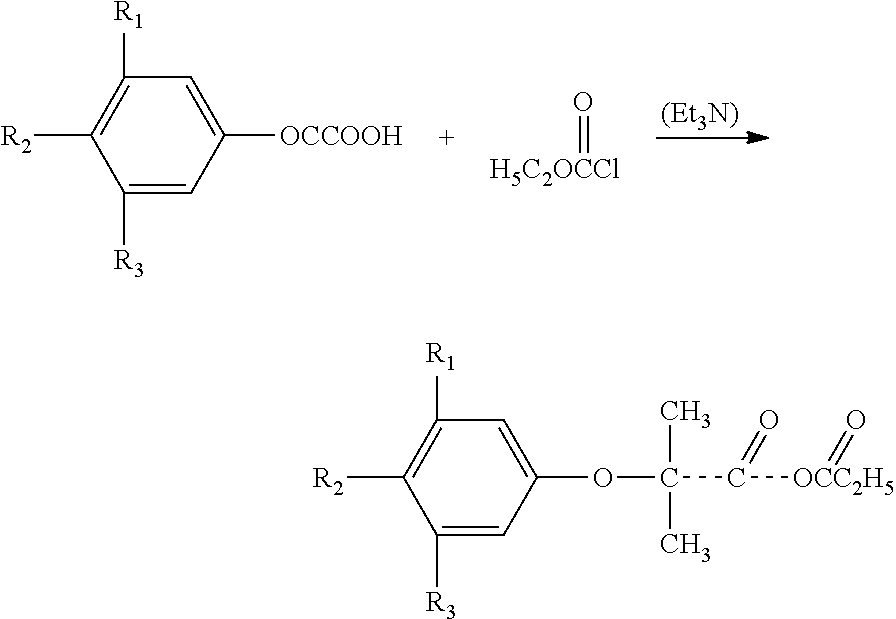Amino acid amides of phenoxybutyric acid derivatives
a technology of phenoxybutyric acid and amides, which is applied in the field of compounding, can solve the problems of severe structural and functional changes in protein/protein and protein/cell interaction in the vascular wall, severe consequences on affected organs, and inability to understand the mechanisms of hyperglycemia-induced tissue damage in diabetes, etc., to prevent skin wrinkles, reduce serum cholesterol, and improve the effect of lipid metabolism
- Summary
- Abstract
- Description
- Claims
- Application Information
AI Technical Summary
Benefits of technology
Problems solved by technology
Method used
Image
Examples
example 1
[0061]To a stirring mixture of 1 mole of clofibric acid (2.145 g) in 25 ml of tetrahydrofuran and 1.4 ml of triethyl amine on an ice-salt bath is slowly added 1 ml of ethyl chloroformate and a solution of 1.3 g (0.01 mole) of 4-aminobutyric acid in 7.5 ml of 2N aqueous sodium hydroxide with 15 ml of tetrahydrofuran. After one hour of stirring at room temperature, most of the tetrahydrofuran evaporated. The aqueous solution was filtered over Celite and acidified with citric acid. After two hours in a refrigerator, the solid was filtered and air dried giving 2.7 g of product (approximately 90% yield) mp 95-97° C. The white powder may be crystallized from aqueous isopropanol without changing the melting point.
[0062]This compound has the following formula:
example 2
[0063]One mole of the following compound:
is dissolved in 8 ml of tetrahydrofuran, 0.15 ml of triethyl amine and 0.1 ml (approximately 0.1 mmole) of ethylchloroformate is added to and cooled on an ice salt bath for 0.5 hours. A solution of 3-aminobutyric acid in 1.2 ml of aqueous 1 N NaOH is added to the previously prepared solution and an off white precipitate is formed. After the addition of 15 ml of water and acidification with citric acid, the precipitate was filtered, washed with water and dried giving 456 mg (97% yield) of a white product mp 96-98° C. having the following formula:
example 3
[0064]To a cold solution of 382 mg of a compound of the formula:
in 8 ml of tetrahydrofuran is added 0.15 ml (approximately 1 mmole) of triethylamine and 0.1 ml (approximately 1 mmole) of ethylchloroformate and the mixture is stirred for 0.5 hours and a solution of 107 mg (1.1 mmole) of glycine in 2 ml of aqueous 1 N NaOH with 3 ml of water is added and stirred for 0.5 hours at room temperature prior to adding 20 ml of water. The tetrahydrofuran is evaporated, the mixture is cooled and acidified with citric acid. A off white precipitate forms which is washed with water and dried to give 400 mg (yield 90%) mp 101-103° C. of a product of the formula:
PUM
| Property | Measurement | Unit |
|---|---|---|
| temperature | aaaaa | aaaaa |
| temperature | aaaaa | aaaaa |
| melting point | aaaaa | aaaaa |
Abstract
Description
Claims
Application Information
 Login to View More
Login to View More - R&D
- Intellectual Property
- Life Sciences
- Materials
- Tech Scout
- Unparalleled Data Quality
- Higher Quality Content
- 60% Fewer Hallucinations
Browse by: Latest US Patents, China's latest patents, Technical Efficacy Thesaurus, Application Domain, Technology Topic, Popular Technical Reports.
© 2025 PatSnap. All rights reserved.Legal|Privacy policy|Modern Slavery Act Transparency Statement|Sitemap|About US| Contact US: help@patsnap.com



